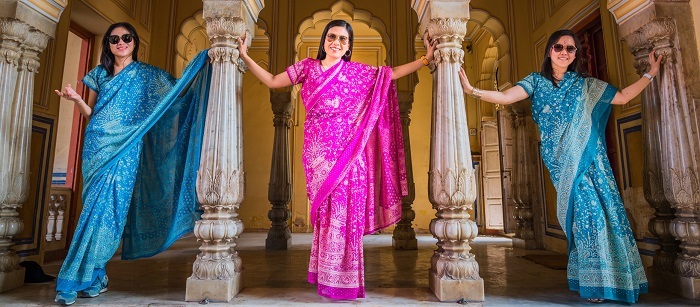

Sari is a traditional garment worn by women in India and other South Asian countries. Its origin dates back to ancient times and its evolution can be traced through historical records, artwork, and literature. The sari has been adapted to suit changing fashion trends but continues to be an important symbol of cultural identity and femininity.

The history of the sari can be traced back to the Indus Valley Civilization, which existed from 2800 to 1800 BCE. Historical evidence suggests that women in ancient India draped a length of cloth around their bodies, which served as a precursor to the modern-day sari.
During the Vedic period (1500-500 BCE), the sari began to take on its characteristic form, consisting of a long piece of cloth draped around the body with pleats and a pallu (a decorative endpiece) over the shoulder.
Over time, the sari evolved to incorporate different styles and techniques of draping, influenced by cultural and regional differences in South Asia. For example, the Nivi drape, which is the most common style of wearing a sari today, originated in Andhra Pradesh in the early 20th century.
Throughout history, the sari has been worn by women of different social and economic classes in South Asia. It has also been featured in various forms of art, literature, and media, and has played a significant role in shaping the cultural identity of South Asia. Today, the sari continues to evolve and adapt to changing fashion trends while remaining a timeless symbol of tradition and femininity.
The emergence of the sari can be attributed to several factors including −
Climate − The hot and humid climate of South Asia made it necessary for people to wear loose, comfortable clothing. The sari, with its flowing fabric and versatile draping style, provided an ideal solution.
Cultural and social norms − The sari became an important part of South Asian culture and tradition, with different regions developing their own unique styles and variations of the garment. It was also seen as a symbol of femininity and grace, and was often worn on special occasions and festivals.
Cotton, silk, and other natural fibers were widely available and affordable, making them popular choices formaking saris.
Influence of trade and migration − Trade and migration between different regions of South Asia led to the exchange of ideas and cultural practices, including the style and design of clothing. This contributed to the diversity and richness of the sari as a garment.
Influence of colonialism − The arrival of the British in South Asia had an impact on the design and production of saris. The demand for lighter and more comfortable fabrics, as well as the introduction of new weaving techniques, led to the creation of new styles and designs of saris.
These are just a few factors that contributed to the emergence of the sari in South Asia. The sari continues to be an important part of the cultural and social fabric of the region, and remains a timeless and elegant garment that is revered and cherished by many.
During the emergence of the sari, different regions of South Asia developed their own unique styles and variations of the garment. Here are some examples −
Nivi drape − Originating from Andhra Pradesh, this style involves tucking the pleats of the sari into the waistband and draping the pallu over the left shoulder.
Bengali style − Worn mainly in West Bengal and Bangladesh, this style features a broad pleat in the front and the pallu draped over the left shoulder.
Gujarati style − Hailing from the state of Gujarat, this style involves tucking the pleats in the back and draping the pallu over the right shoulder.
Maharashtrian style − Popular in Maharashtra, this style involves draping the sari in a dhoti style with the pallu draped over the left shoulder.
Tamilian style − Common in Tamil Nadu, this style involves draping the sari with the pleats facing the right and the pallu draped over the left shoulder.
These are just a few examples of the regional variations and styles of the sari that emerged during its early history. Each style reflects the cultural and social traditions of the region and adds to the diversity and beauty of the sari.

In ancient times, saris were made using a variety of fabrics and materials, depending on the region and the availability of resources. Here are some examples −
Cotton − Cotton was one of the most commonly used fabrics for making saris. It was widely available and affordable, making it a popular choice for everyday wear.
Silk − Silk was a luxury fabric that was often reserved for special occasions and formal events. Different types of silk, such as Banarasi silk, Kanchipuram silk, and Tussar silk, were used to create saris with intricate designs and embellishments.
Muslin − Muslin was a lightweight and breathable fabric that was often used for making summer saris. It was also popular for its softness and comfort.
Chiffon − Chiffon was another lightweight and sheer fabric that was used for making saris. It was often used for creating elegant and feminine saris for evening wear. It was commonly used in the eastern regions of South Asia.
These are just a few examples of the fabrics and materials that were used to make saris in ancient times. The choice of fabric often reflected the climate, culture, and social status of the wearer. Today, saris continue to be made using a wide range of fabrics and materials, both traditional and modern.
The sari holds immense cultural and traditional significance in South Asia. Here are some ways in which it is valued and revered −
Symbol of femininity − The sari is considered to be one of the most elegant and feminine garments in the world. It is often associated with grace, beauty, and charm, and is worn by women of all ages and backgrounds.
Cultural identity − The sari is an important symbol of South Asian culture and heritage. It is deeply rooted in the traditions and customs of the region and is often worn on special occasions and festivals.
Bridal attire − The sari is a popular choice of attire for weddings and other festive occasions. It is often embroidered with intricate designs and embellishments, making it a highly sought-after bridal garment.
Religion − In Hinduism, the sari is worn by women during religious ceremonies and rituals, and is considered to be a symbol of purity and devotion.
Economic importance − The sari industry is a significant contributor to the economy of South Asia. It provides employment opportunities to millions of people, from weavers and artisans to designers and manufacturers.
Overall, the sari holds a special place in the hearts and minds of people in South Asia, and is celebrated for its beauty, elegance, and cultural significance.
The sari is a traditional garment that has been worn by women in South Asia for centuries. It has evolved over time, adapting to changing styles and cultural practices, but has remained an integral part of the region's identity and heritage. The sari's significance extends beyond its beauty and elegance, as it is also an important symbol of femininity, cultural identity, and religious devotion. Its emergence can be attributed to a variety of factors, including climate, cultural and social norms, availability of resources, trade and migration, and colonialism. Today, the sari continues to be celebrated and revered in South Asia and beyond, and remains an enduring symbol of grace, beauty, and tradition.